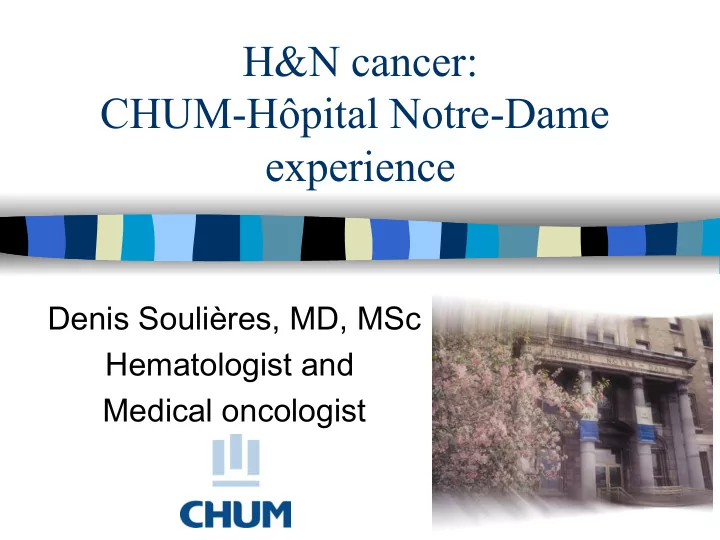

H&N cancer: CHUM-Hôpital Notre-Dame experience Denis Soulières, MD, MSc Hematologist and Medical oncologist
Chemoradiation therapy Objectives: – Increase in survival • Better local control • Decrease occurrence of distant metastasis – Organ preservation • Larynx • Oropharynx – Quality of life • Tolerability of the proposed therapy
Therapeutic schemes: Primary systemic therapy followed by radiation therapy Concomitant chemoradiation therapy • Primary • Post-op Adjuvant chemotherapy • Post-radiation • Post surgery and radiation therapy
Pignon JP, Bourhis J, Domenge C, Designe L. Chemotherapy added to locoregional treatment for head and neck squamous- cell carcinoma: three meta-analyses of updated individual data. MACH-NC Collaborative Group. Meta-Analysis of Chemotherapy on Head and Neck Cancer. Lancet 2000;355(9208):949-55.
Pignon et al.
Meta-analysis: Chemotherapy Pignon Overall survival CT ! Risk ! p ! Benefit Timing ! Reduction ! value ! at 5y ! Adjuvant ! 2% ! N.S 1% ! Induction ! 5% ! N.S 2% ! Concomitant ! 19% ! < 0.0001 8% ! 11% ! < 0.0001 4% ! Total !!
Updated Pignon meta-analysis
Update of MAHN-NC
Experience Notre-Dame Median age: 57 yo 245 (77%) M and 73 (23%) F Stage III 48 (15%) and stage IV 270 (85%) Site: – 67% oropharynx – 13% larynx – 7% hypopharynx – 18% autres Median follow-up 19 mois
Experience Notre-Dame Carbo/5-FU q 3 sem: 178 (56%) CDDP q 3 sem: 86 (27%) Carbo die: 42 (13%) CDDP die : 6 (2%) CDDP q 1sem: 4 (2%)
Experience Notre-Dame Surgery for any residual disease detected clinically or radiologically (primary site and/or nodes)
Experience Notre-Dame Tx: 14 (4)% T1: 42 (13%) T2: 63 (20%) T3: 104 (33%) T4: 95 (30%)
Experience Notre-Dame N0: 33 (10%) N1: 43 (14%) N2: 190 (60%) N3: 52 (16%)
Overall survival ! OS at 2y: 70% ! OS at 3y: 63% ! !
Loco-regional control ! LRC at 2y: 88% ! LRC at 3y: 85% ! !
Distant DFS Distant metastatic disease: At 2y: 13% At 3y: 16%
Influence on the type of chemotherapy
OS based on the type of chemoRx ! carbo + 5FU or cisplatin q 3w vs others ! * p value < 0,0001 !
Distant DFS according to type of ! chemotherapy carbo + 5FU or cisplatin q 3 w vs others ! * p value < 0,0001 !
The effect of HPV: HND experience HPV prevalence and prognostic value in a prospective cohort of 255 patients with locally advanced squamous cell carcinoma of the head and neck treated with chemoradiation therapy
Introduction and methods Background and objectives – HPV prevalence in HNSCC increasing over the past few decades • Clinically and molecularly different subset – Improved prognosis for HPV+ cancers – Most data derived from trials with different treatment options or small heterogeneous cohorts, and often collected retrospectively. – Objective: to determine HPV prevalence and effects of tumour HPV status on treatment response and survival outcomes amongst HNSCC uniformly treated patients 27
Methods Prospective data on efficacy and toxicity available for 560 patients treated with concomitant CRT 270 fixed and paraffin embedded specimens; sufficient tissue for DNA extraction in 255 samples Presence of HPV DNA in samples determined using the Roche Linear Array detection method (LA-HPV) • Coutlee, F., et al., Enhanced detection and typing of human papillomavirus (HPV) DNA in anogenital samples with PGMY primers and the Linear array HPV genotyping test. J Clin Microbiol, 2006. 44 (6): p. 1998-2006 Statistical analysis: – Kaplan-Meier survival curves – Fisher’s test for categorical data – Log-Rank statistics for failure times
Results: Patient characteristics Patient Characteristic Number % HPV + 175 68.63 - 80 31.37 Age (years) Median 57.00 Range 25.25-78.72 TNM Stage I 0 0 II 2 0.78 III 35 13.73 IVa 166 65.10 IVb 44 17.25 Recurrence 8 3.74 KPS 60 1 0.47 70 4 1.89 80 41 19.34 90 148 69.81 100 18 8.49 Chemotherapy Daily carboplatin or cisplatin 27 10.63 Daily Carboplatin + 5FU 146 57.48 Cisplatin q 1 week or q 3 81 31.89 weeks Radiotherapy 221 86.66 Conventional 34 13.33 IMRT
Results:
Results: OS for oropharynx
Results
Results:
Discussion: Our results confirm the HPV is a pronostic factor for OS, DFS and LCR in locally advanced HNSCC – Specifically for patients treated with chemoradiation therapy Our data neither confirm nor infirm that HPV- related HNSCC can be treated with a less stringent therapy – The development of chemoradiation therapy in cervical cancer seems to argue for more intensive therapy
Perspectives: HPV genotyping should be a stratification factor for all clinical trials including HNSCC cases Interaction assays should be incorporated in all future HNSCC trials – Differenciate the pronostic and predictive value of HPVbased on different therapies Different biology of HPV disease argues for different agents and separate trials
Perspectives: Large cohorts of patients treated with chemoradiation are required to establish: – Prognostic factors – Predictive factors – Revision of staging based on new therapies
Recommend
More recommend